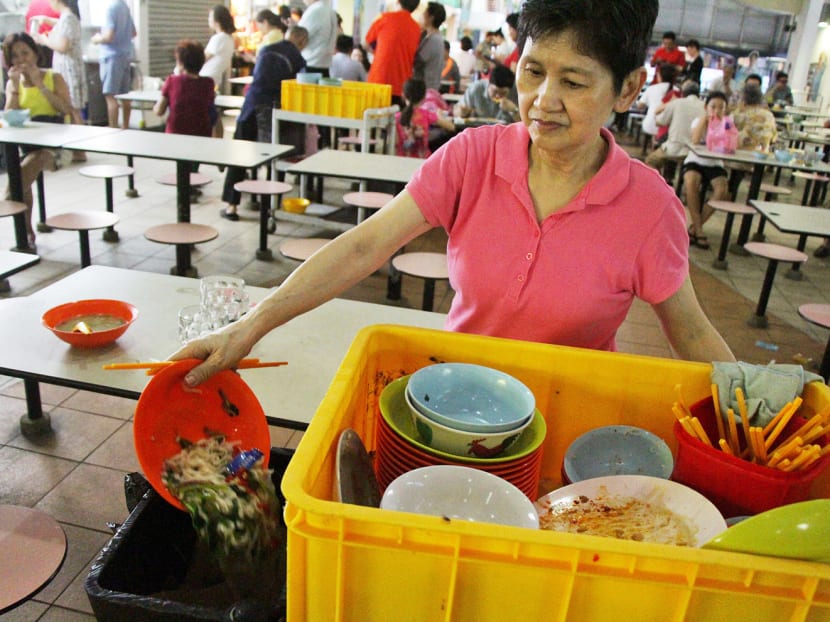Two hawker centres to get new food waste recycling machines
SINGAPORE — Food waste recycling machines will be placed at two of Singapore’s larger hawker centres in a two-year pilot, as part of the authorities’ overall efforts to curb the growing volume of food waste in Singapore.
SINGAPORE — Food waste recycling machines will be placed at two of Singapore’s larger hawker centres in a two-year pilot, as part of the authorities’ overall efforts to curb the growing volume of food waste in Singapore.
These machines are expected to reduce the volume of food waste at the hawker centre by at least 90 per cent each day.
The National Environment Agency (NEA) called for a tender yesterday for vendors to supply the machines at Tiong Bahru Market and Ang Mo Kio Block 628 Market.
Contractors will have to lease and maintain two food waste recycling machines that can convert one-tonne worth of food waste from the hawker stalls to either water or compost. They are also expected to provide training and infrastructure for cleaners and stall holders to properly segregate food waste, said the NEA.
“The pilot aims to test the economic viability and operational feasibility of food waste segregation and recycling in hawker centres, as part of the Government’s efforts to move towards being a zero-waste nation,” a spokesperson said.
The tender will close on June 4, and the pilot is expected to be launched between October and December.
The two hawker centres were chosen based on the number and mix of stall types they had, as well as the space to house the machines. The centres at Tiong Bahru and Ang Mo Kio have 342 and 219 stalls respectively. TODAY understands that a good mix of stalls from these centres would provide more representative pilot results.
The pilot was first announced by Second Minister for the Environment and Water Resources Grace Fu in March.
Food waste accounts for about 10 per cent of the total waste generated in Singapore, but less than 15 per cent of it is recycled. Last year, 788,600 tonnes of food waste were generated, of which only 13 per cent was recycled. The rest of the food waste was disposed of at incineration plants, then landfilled.
Over the past 10 years, food waste has increased by about 48 per cent and is expected to rise further with a larger population and greater wealth.
Commenting on the pilot yesterday, Ang Mo Kio Block 628 Market’s hawker association chairman Lim Joo Song, 65, said while the pilot is a good idea, some hawkers were concerned with the extra work involved in segregating the food waste.
Mr Lim, who has been selling fresh seafood at the centre for 25 years, is also worried about machine breakdowns if the food waste isn’t properly segregated.
With a food recycling machine within the centre, Tiong Bahru Market’s hawker association’s general affairs representative Tan Soon Cheah, 54, felt it would make the recycling process cleaner as food waste would not be left in the open for long periods.
He suggested monetary incentives to encourage stallholders to change their mindsets and make a conscious effort to separate their food waste.
According to the tender documents, contractors will have to provide a project report every three months detailing the amount of food waste processed and incident and training reports, among other things.
At least once a day, contractors have to man the basic operations of the machine together with the cleaners, weigh and record the amount of food waste input, and the contaminants removed, among other tasks.
Contractors also need to have at least one year of “successful experience” in processing food waste in Singapore or elsewhere, and have sufficient trained personnel to provide service support.
Eco-Wiz, a local supplier of food waste digestors, has expressed interest in submitting a bid for the tender. “It’s very good for us to participate and try to encourage more food waste (to) be recycled rather than to go to the incinerator,” said chief executive officer Renee Mison, who believes Singapore will move in the direction of food waste recycling eventually.
A food waste digester with one-tonne capacity can cost about S$100,000 and take up about 15 sq m of floor space, said Ms Mison.
Supplying food waste digestors to hawker centres instead of hotels could mean a longer training period in the segregation of food waste, she added. “You are dealing with hundreds of different stall owners, so you have to educate them one by one.”










